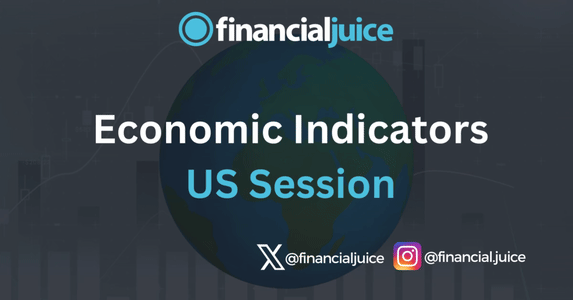
Week Ahead: Economic Indicators (US)
Hey, Traders!
For the May 20th week, here is a list of all of the major economic indicators being released during the US Session, with a brief synopsis of what they represent and what to possibly expect from the markets in reaction.
Tuesday 21st May
08:30 ET
Canadian CPI for April
The Canadian Consumer Price Index is a measure of the average change over time in the prices paid by urban consumers for a basket of goods and services.
It’s one of the key indicators used to gauge inflationary pressures in the Canadian economy.
The CPI is calculated monthly by Statistics Canada, the country’s national statistical agency.
The basket of goods and services included in the CPI represents the typical spending patterns of Canadian households. It covers a wide range of categories, including food, shelter, transportation, clothing, healthcare, and recreation. Each category is weighted based on its relative importance in household spending.
What to Expect
If CPI comes in higher than expected, this is likely to cause the markets to push back on bets for Canadian rate cuts this year, which could cause weakness in Canadian stocks, and strength in the Canadian dollar.
if it comes in lower than expected, you could expect the opposite reaction, as it could confirm that the BoC is in a position to cut rates.
Wednesday 22nd May
10:30 ET
US Existing Home Sales for April
Existing Home Sales in the United States refers to the number of previously constructed homes (single-family houses, townhouses, condominiums, and co-ops) that were sold during a particular month.
This statistic is released monthly by the National Association of Realtors (NAR) and is considered a key indicator of the health of the housing market.
Existing home sales data provides insights into the level of demand for housing, the pace of homebuying activity, and overall market conditions.
Factors that can influence existing home sales include mortgage interest rates, housing affordability, employment trends, consumer confidence, and economic conditions.
This data can impact various sectors of the economy, including construction, finance, and consumer spending.
What to Expect
This data is unlikely to move the markets meaningfully, minus a large surprise deviation from expectations.
However, the data is still useful as an indicator of consumer confidence, as well as a preliminary gauge that can influence other areas of the economy, as mentioned above.
10:30 ET
US Weekly EIA Crude Oil Inventories
The US Weekly Energy Information Administration Crude Oil Inventories report provides data on the total amount of crude oil held in storage facilities across the United States. This report is released every Wednesday by the EIA, a branch of the US Department of Energy.
Traders and investors use the EIA Crude Oil Inventories report to assess the balance between supply and demand in the oil market and anticipate future price movements.
What to Expect
A larger-than-expected storage build could indicate oversupply in the energy market, adding potential downward pressure to oil prices.
While a lower-than-expected build, or even a draw in Crude inventories, could indicate scarcity, which could cause strength in oil prices.
14:00 ET
FOMC Meeting Minutes for the May meeting.
The Federal Open Market Committee Meeting Minutes are comprehensive records of the discussions and decisions made during the Federal Reserve’s FOMC policy meetings.
These meetings are held approximately eight times a year to set monetary policy in the United States.
The FOMC Meeting Minutes provide valuable insight into the Federal Reserve’s thinking and decision-making process, helping to guide market expectations and shape economic policy discussions.
What to Expect
Markets are looking for any forward guidance and indication outside of what is already priced in.
Namely, they will be looking for any mentions on discussions of interest rate cuts, or a lack thereof.
More hawkish comments which indicate a reduced chance of interest rate cuts this year, could lead to weakness in US stocks, and strength in the dollar.
Whereas a more dovish tone could push forward bets of interest rate cuts this year, causing strength in US stocks and weakness in the dollar.
Thursday 23rd May
09:45 ET
US S&P Manufacturing & Services May Prelim PMIs
The US S&P Manufacturing and Services Preliminary Purchasing Managers’ Indexes provide early insights into the health and performance of the manufacturing and services sectors in the United States.
These indexes are based on surveys of purchasing managers at businesses, where they report on various factors such as new orders, production levels, employment, and supplier deliveries.
As a diffusion index, a PMI reading above 50 indicates expansion in the sector, while a reading below 50 indicates contraction.
The preliminary PMIs are released a week or so before the final PMI figures and offer an initial snapshot of economic activity for the current month.
What to Expect
If the PMI’s come in higher than expected, this shows growth within the sectors, despite the high interest rates.
This could mean businesses are still doing well, possibly causing an up-side risk to inflation, feeding into the “higher for longer” rate narrative, especially in the services sector, which has been cited by Fed officials as being a headwind to the Fed’s 2% inflation target due to its resilience.
If realized, this could show strength in the dollar and weakness in US stocks.
The opposite is also true, if it comes in lower than expected, this could indicate that interest rates are having the desired effect of slowing demand for goods and services, which could push forward bets on rate cuts, causing strength in US stocks and weakness in the dollar.
10:00 ET
US New Home Sales for April
US New Home Sales is a monthly economic indicator released by the US Census Bureau and the Department of Housing and Urban Development.
It measures the number of newly constructed homes that were sold during the previous month.
New home sales data provides insights into the health and activity of the housing market, as it reflects consumer demand for newly built homes.
A higher number of new home sales typically indicates a strong housing market, suggesting positive consumer confidence, economic growth, and job prospects.
What to expect
This data is unlikely to move the markets unless a large deviation from the expected is seen.
This data can be used as an indicator of consumer confidence, as well as a gauge of other areas of the economy, like employment prospects and economic growth.
Friday 24th May
08:30 ET
US Durable Goods April Prelim
The US Durable Goods Orders Preliminary Report provides early estimates of orders for long-lasting manufactured goods, such as machinery, appliances, and transportation equipment.
This data is an indicator of business investment and consumer confidence, as durable goods purchases typically require a significant capital outlay and reflect long-term economic expectations.
Higher-than-expected orders suggest potential economic growth and increased business activity, while lower-than-expected orders may indicate a slowdown in manufacturing and overall economic activity.
Policymakers and investors analyse this report to gauge the health of the manufacturing sector and make informed decisions about future economic trends.
What to Expect
If durable goods come in higher than expected, this could also mean there is higher consumer demand for durable goods, possibly leading to an upside risk for inflation.
This could mean strength in the dollar and weakness in US stocks.
If it comes in cooler than expected, the opposite could be expected.
10:00 ET
University of Michigan Sentiment Survey May Final
The University of Michigan Consumer Sentiment Index measures the confidence of US consumers in the economy. It is based on a survey that assesses consumers’ perceptions and expectations regarding their personal finances, business conditions, and overall economic prospects.
A higher sentiment index indicates increased confidence, which can positively impact consumer spending and economic activity, while a lower index may suggest reduced confidence and potential economic caution.
What to Expect
Consumer sentiment is watched by markets to assess consumer resilience in a high-interest-rate environment. Elevated sentiment may suggest strong demand, potentially leading to inflationary pressures, but it could also signal consumer resilience, reducing recession fears.
In this release, the market focus has been on the 1 & 5-year inflation expectations accompanying the sentiment data.
Higher inflation expectations may delay Fed rate cut expectations, affecting US stocks negatively and strengthening the dollar.
If the inflation expectations come in lower than expected, the opposite could be true.



